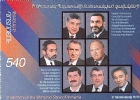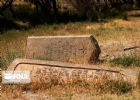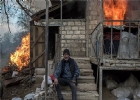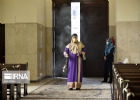
English :
24 Aralık 2021
![]()
![]()
![]()
Acitizen of the Republic of Turkey, I was born to a Kurdish mother and an Arab father in the southeastern city of Gaziantep, formerly known as Aintab (35 miles to the west of the Euphrates and 28 miles to the north of today’s Turkish-Syrian border). Growing up in a multilingual household but being taught only Turkish, I was a living manifestation of the national pattern of the oppressor, which continued over the course of my entire education.
After my graduation from Middle East Technical University in Ankara, I found myself again at my parents’ house in my hometown, where I escaped the stifling heat and passed the days dozing on the sofa.
One day I was woken up from my nap by a call from an old friend: “Ümit, where have you been? It’s been ages! I know a great place in Kayacık where we can catch up.” Though I was born and raised in Aintab and hadn’t left the city until college, the word “Kayacık” did not mean anything to me. It was just another district in the city, a neighborhood I had never visited, of which I knew nothing.
She said she would wait for me at Papirüs Café and gave me directions. I took a bus to the Kayacık neighborhood and upon arrival found myself dazed by the charming atmosphere, letting myself get lost in the side streets, leaving my poor friend waiting. Transfixed, I found myself asking: “Where am I? What is this place?”
I was on a narrow street with beautifully constructed stone houses lining each side, taking me back to a simpler time. Tucked away among the high-rise concrete apartment buildings of “modernized” Gaziantep, this neighborhood, with its traditional architecture, was like a mirage. I felt nostalgic for a past that was never mine.
Eventually, I found Papirüs Café, which turned out to be located in one of those traditional houses. Like most of the houses on the street, it had been converted into a café as part of the process of “restoring” the city. When I entered, a few letters carved at the top of the majestic gate caught my eye. Not recognizing the script, I assumed these were Ottoman characters.
Inside, I was once again left speechless. A spacious courtyard with staircases on either side leading up to two large rooms welcomed me. The rooms were filled with antique furnishings, and the high ceilings were adorned with frescos and engravings similar to Florentine cathedrals. The experience was a kind of historical voyeurism, like stepping into a living museum.
Feeling a surge of pride in my hometown and ancestors, I decided to talk to the owner to learn something of the house’s history. I approached him, intending to begin by complimenting his establishment. But before I could stop myself, I asked: “I was just wondering, from whom did you get this place? Who was here before you?”
He warily explained that he inherited the building from his grandfather. It must have been especially strong coffee they were serving that day, as I was emboldened to press further. “And how about your grandfather? From whom did he buy this place?” The man hesitated before murmuring softly to the ground, “There were Armenians here.” Confused, I blurted out a series of questions: “What Armenians? What are you talking about? Were there Armenians in Gaziantep?” He nodded, but I was getting annoyed with the opacity of his answers. “So, what happened to them? Where did they go?” He retorted indifferently: “They left.”
As I rode the bus back home, I pondered why the Armenians — why anyone — would just leave and hand over such an exquisite property to someone. I was a bit naïve — an ignorant, 22-year-old university graduate unaware of the existence of Armenians in my hometown.
A few years later, I would find out that the house belonged to Nazar Nazaretian, honorary consul to Iran, who was a member of Aintab’s wealthiest and most prominent family, and that he, his children and his grandchildren used to live in the house. Those letters above the gate were not Ottoman but Armenian, spelling out the surname of Kara Nazar Agha, the person who built the house. Years later, I would also have the chance to meet the youngest member of the family, Shusan, whose grandmother was deported at the age of 1 during the 1915 Armenian genocide. Shusan kindly spoke Turkish to me in the Aintab dialect.
That building is no longer Papirüs Café for me. For me, it is the house of Kara Nazar Agha, the Nazaretians’ home, the house where the grandmother of Shusan was born.
In Turkish, there is a saying: “Mal sahibi, mülk sahibi, hani bunun ilk sahibi?” Roughly translated, it means, “Landlord, property owner, where is the original owner?” Armenians of Aintab were torn away from their homes, neighborhoods and the city where they were born and raised. Their material and spatial wealth changed hands and was transformed. The entire Armenian dispossession produced the homogeneous Turkish city where I grew up. The fortunes of wealthy families today were built by robbing the Armenians and often murdering their neighbors. Sealed in stone as well as blood, it was a criminal bargain that constituted the wobbly foundations of Turkish society.
In the aftermath of the Turkish-French War in 1921-22 (known as Antep Harbi), there was a town crier who walked around town, inviting those who had participated in the war to come to Tuz Hanı (The Salt Caravansary). Many locals of Aintab, including Ali Beşe (a prominent member of the Aintab gentry), headed over. A man told them to line up in twos, as they would let people in two at a time. When it was Beşe’s turn, he went in and saw some keys placed on a rug. “Each person takes two,” the man in charge commanded. There were also medallions lying on the rug. After a quick glance, Beşe said, “So, that’s what we saved Aintab for? For two keys and a piece of tin? Thanks,” he said. And he left, seemingly of the view that he deserved a greater reward for his efforts. The keys on the rug belonged to the Armenians whose homes now stood vacant.
Beşe played a pivotal role in the deportation of Armenians and liquidation of their properties. Trusted by Turkey’s first president, Mustafa Kemal Atatürk, Beşe had close ties with the Committee of Union and Progress (CUP), then the Ottoman government, and political elites in Istanbul. He wielded influence in the post-war and republican periods and took charge of helping the fledgling nation-state raise a group of entrepreneurs in Gaziantep.
From 1922 to 1928, some of the houses that belonged to Armenians were used for charitable purposes, distributed at no charge by the state and the Aintab municipal authority to Muslim families who had lost their own dwellings during the Turkish-French War. According to a local, these impoverished Muslim families were given small or neglected Armenian houses. This was the fate, in 1922, of the house owned by the father of Harutyun Nazarian, who was forced to leave Aintab and settle in Aleppo along with the rest of his family when he was 15. In a memoir, Nazarian recalled the event:
“Before we left the house, a state official accompanied by two women came into our yard early in the morning. Then the official said, ‘As you are leaving Aintab and the houses of these two women were demolished due to the battle and bombardments, and in addition to that, since the state and local government have authorized you to leave Aintab, your house along with other empty houses will be occupied by others.’ He also asked these two women how many rooms there were in their wrecked houses. In this manner, our house was registered onto the list of other occupied houses.”
The remaining properties were also distributed among newly resettled immigrants. Several years after the war, Armenians’ abandoned houses and estates were still being used to settle immigrants and muhajirs (refugees). A telegram on Aug. 17, 1924, sent by the Ministry of Population Exchange, Development and Settlement (Mübâdele, İmar ve İskân Vekâleti İskân Şubesi) to Gaziantep province reported that there had been 19,500 Armenians in the province, whose houses and estates, following their departure, could accommodate a large number of muhajirs, and directed that these muhajir families be settled on these properties according to their needs. As late as 1928, the distribution of Armenians’ land and housing to Muslim immigrants in Gaziantep continued. For example, on Nov. 3, 1925, the Ministry of Interior approved an application submitted by Hasan Effendi, an immigrant from Kars, to settle in Gaziantep. On Nov. 7, the provincial government was instructed to provide housing for Hasan Effendi and his family from the stock of abandoned properties.
In the immediate aftermath of the Turkish-French War, prominent and affluent local elites looted large, Armenian-owned houses with impunity. Ali Api obtained Garuc Karamanougian’s mansion in 1924. After changing hands a few times, Hasan Süzer, a businessperson from Aintab, bought and restored the building in 1985. It was then donated to the Ministry of Culture and Tourism on the condition that it would serve as Hasan Süzer Etnografya Müzesi (Hasan Süzer Ethnography Museum).
Individuals with connections to state organs were also well placed to take advantage of the situation. Ahmed Hurşid Bey and Nuri Patpatzâde, both members of Aintab Central Committee and financiers of local forces (kuva-yı milliye), seized Armenian estates. Ahmed Hurşid Bey claimed Pirenian’s large house in 1922 and later paid a symbolic price for it at an auction. Meanwhile Patpatzâde usurped the houses of Hagop Bezjian and Harutyun Aghian in 1923.
Starting in the 1920s, the state organized auctions through the Gaziantep Municipality and Gaziantep Internal Revenue Office to complete property transactions. The auctions, however, were largely symbolic; they facilitated the embezzlement of the spoils while lending an air of officiality to the process. From 1930 to 1935, these so-called transactions were even announced in the local newspaper, the Gaziantep Gazetesi, the notices of which detailed the quantity, date, time, approximate location, type, value in liras and — most important — previous owners of properties. However, information on the buyers was not provided. To illustrate, a parcel of land owned by Hanna Kurkchuian, valued at 250 liras, was auctioned for 30 liras in 1934; a parcel of land owned by Avedis Nacarian, valued at 60 liras, was sold for 10 liras in the same year; Zenop Bezjian’s shop, valued at 216 liras, was auctioned for 150 liras in 1935; and around the same time, Abraham Babikian’s vineyard was sold for 15 liras, far below its actual value.
Some notable locals collaborated to decrease the price of the abandoned properties, allowing many of today’s prominent families to enlarge their fortunes by purchasing these assets for a pittance. Among the buyers of these auctioned properties, Daizâde Mahmut is of particular interest. As a member of a leading wealthy Aintab family, he served as the chair of the Gaziantep Chamber of Commerce from 1921 to 1924. In 1923, he purchased Garabed Nazaretian’s house, which was put up for sale by the Gaziantep Municipality. By this time Garabed Nazaretian was deceased, but his daughters, who held Iranian citizenship, submitted a formal objection to this sale through the Iranian Embassy. Thereupon, the embassy sent an oral notice to the Istanbul Office of the Foreign Affairs Commissariat of the Turkish Grand National Assembly on Feb. 5, 1923, requesting a halt to the sale of the property. The sale procedure, the Iranian Embassy added, was illegal, and the property in question had to be returned to its rightful owners. This oral notice was later presented to the Ministry of Foreign Affairs, but to no avail. Despite this protest, the sale transaction was finalized.
A former employee of the Nazaretian family, Daizâde Mahmut became an affluent merchant and lived in the mansion until it was donated to the military to be used as a gendarmerie station in 1965. After the departure of military forces in 1967, the Daizâde family sold the house to its current owner Abdülkadir Kimiazâde (today known as Kimya), a wholesaler and real estate agent. The building was used as a residential house, warehouse and drying room until the 1980s. The Kimya family rented the dilapidated house in the 1990s. Until its restoration in the mid-2000s, it was used as a dormitory. Today, with its eight owners from the Kimya family, it is the Papyrus Café. Both the Daizâde and Kimiazâde families actively supported and participated in the deportations in return for Armenian properties.
Additionally, Daizâde Mahmut bought Nazaretian’s other estates in Aintab. For example, the Kara Nazar Inn, later called Büyük Pasaj (Grand Bazaar, still standing at the city center, replete with a myriad of shops), was transferred to the Gaziantep Internal Revenue Office as a national estate and sold to Mahmut Daizâde for a nominal price. A few years later, at a 1934 auction, his son İhsan Dai purchased the house of the prominent Armenian Sarkis Krajian.
A house belonging to Dr. Avedis Jebejian was acquired by the Konukoğlu family, the wealthiest industrialist family of Gaziantep. In 2011, the family donated the house to the Gaziantep Metropolitan Municipality. Two years later, the municipality opened it to the public as Gaziantep Atatürk Anı Müzesi (Atatürk Memorial Museum of Gaziantep). In 1989, one of the Nazaretian houses was converted for use by the Konukoğlu Vakfı (Konukoğlu Foundation). One of the houses that belonged to Hagop Aslanian’s family before their deportation in 1915 is now being used as a hotel, the Anatolian Houses Boutique Hotel.
In another example, the buildings of the Atenagan School and Surp Bedross Yegeghetsi (Second Catholic Church) were passed on to the National Estate after Armenians were forced to vacate the city. Later, in 1933, these buildings were turned into Veliç İplik ve Dokuma (thread and weaving factory) and given to Cemil Alevli, then a young native of Aintab, by special order of Atatürk, as part of the effort to create a class of entrepreneurs and capitalists in the city.
With a Western education as his “social capital” and with Atatürk acting as his “venture capitalist,” Alevli became the biggest textile supplier of Aintab in the Turkish Republic. He admitted that he had learned the textile business from Aintab’s Armenians. “Since my childhood,” Alevli said, “I used to watch how Armenians in my neighborhood worked on their textile looms for hours as I headed back and forth to school. I was amazed to follow how Armenian weavers created beautiful fabrics by combining various tones of red, yellow, green, blue and white thread cones.”
Known as the “founding father of the textile industry” in Gaziantep, Alevli later became a member of the Republican People’s Party (CHP) and served as the president of its Gaziantep bureau from 1941 to 1946. Additionally, he served as a CHP deputy in Parliament from 1946 to 1950. His factory was officially named as Ömer Ersoy Kültür Merkezi (Cultural Center) after its restoration in 2008. After acquiring the buildings left behind by the Armenians, brothers Ömer and Mahmut Ersoy also established a yarn factory under the name of “Yüzbaşızâdeler Mahmut and Ömer Mensucat (textiles)” and began production in the formerly Armenian populated Tepebaşı neighborhood in 1927.
As a native son of Gaziantep who has explored the city’s history, I have become aware of the consequences of Armenians’ physical and material destruction at the hands of their former Muslim neighbors. Aside from offering insight into local history, my account also contributes to the broader story of the Armenian genocide.
Unseen in the archived letters, telegrams and property lists are the trauma and suffering of Armenian survivors repeatedly subjected to attacks on their lives, culture, assets and social status. The base motives of their former neighbors left some of the most indelible wounds, which more than a century later remain unhealed.
After my graduation from Middle East Technical University in Ankara, I found myself again at my parents’ house in my hometown, where I escaped the stifling heat and passed the days dozing on the sofa.
One day I was woken up from my nap by a call from an old friend: “Ümit, where have you been? It’s been ages! I know a great place in Kayacık where we can catch up.” Though I was born and raised in Aintab and hadn’t left the city until college, the word “Kayacık” did not mean anything to me. It was just another district in the city, a neighborhood I had never visited, of which I knew nothing.
She said she would wait for me at Papirüs Café and gave me directions. I took a bus to the Kayacık neighborhood and upon arrival found myself dazed by the charming atmosphere, letting myself get lost in the side streets, leaving my poor friend waiting. Transfixed, I found myself asking: “Where am I? What is this place?”
I was on a narrow street with beautifully constructed stone houses lining each side, taking me back to a simpler time. Tucked away among the high-rise concrete apartment buildings of “modernized” Gaziantep, this neighborhood, with its traditional architecture, was like a mirage. I felt nostalgic for a past that was never mine.
Eventually, I found Papirüs Café, which turned out to be located in one of those traditional houses. Like most of the houses on the street, it had been converted into a café as part of the process of “restoring” the city. When I entered, a few letters carved at the top of the majestic gate caught my eye. Not recognizing the script, I assumed these were Ottoman characters.
Inside, I was once again left speechless. A spacious courtyard with staircases on either side leading up to two large rooms welcomed me. The rooms were filled with antique furnishings, and the high ceilings were adorned with frescos and engravings similar to Florentine cathedrals. The experience was a kind of historical voyeurism, like stepping into a living museum.
Feeling a surge of pride in my hometown and ancestors, I decided to talk to the owner to learn something of the house’s history. I approached him, intending to begin by complimenting his establishment. But before I could stop myself, I asked: “I was just wondering, from whom did you get this place? Who was here before you?”
He warily explained that he inherited the building from his grandfather. It must have been especially strong coffee they were serving that day, as I was emboldened to press further. “And how about your grandfather? From whom did he buy this place?” The man hesitated before murmuring softly to the ground, “There were Armenians here.” Confused, I blurted out a series of questions: “What Armenians? What are you talking about? Were there Armenians in Gaziantep?” He nodded, but I was getting annoyed with the opacity of his answers. “So, what happened to them? Where did they go?” He retorted indifferently: “They left.”
As I rode the bus back home, I pondered why the Armenians — why anyone — would just leave and hand over such an exquisite property to someone. I was a bit naïve — an ignorant, 22-year-old university graduate unaware of the existence of Armenians in my hometown.
A few years later, I would find out that the house belonged to Nazar Nazaretian, honorary consul to Iran, who was a member of Aintab’s wealthiest and most prominent family, and that he, his children and his grandchildren used to live in the house. Those letters above the gate were not Ottoman but Armenian, spelling out the surname of Kara Nazar Agha, the person who built the house. Years later, I would also have the chance to meet the youngest member of the family, Shusan, whose grandmother was deported at the age of 1 during the 1915 Armenian genocide. Shusan kindly spoke Turkish to me in the Aintab dialect.
That building is no longer Papirüs Café for me. For me, it is the house of Kara Nazar Agha, the Nazaretians’ home, the house where the grandmother of Shusan was born.
In Turkish, there is a saying: “Mal sahibi, mülk sahibi, hani bunun ilk sahibi?” Roughly translated, it means, “Landlord, property owner, where is the original owner?” Armenians of Aintab were torn away from their homes, neighborhoods and the city where they were born and raised. Their material and spatial wealth changed hands and was transformed. The entire Armenian dispossession produced the homogeneous Turkish city where I grew up. The fortunes of wealthy families today were built by robbing the Armenians and often murdering their neighbors. Sealed in stone as well as blood, it was a criminal bargain that constituted the wobbly foundations of Turkish society.
In the aftermath of the Turkish-French War in 1921-22 (known as Antep Harbi), there was a town crier who walked around town, inviting those who had participated in the war to come to Tuz Hanı (The Salt Caravansary). Many locals of Aintab, including Ali Beşe (a prominent member of the Aintab gentry), headed over. A man told them to line up in twos, as they would let people in two at a time. When it was Beşe’s turn, he went in and saw some keys placed on a rug. “Each person takes two,” the man in charge commanded. There were also medallions lying on the rug. After a quick glance, Beşe said, “So, that’s what we saved Aintab for? For two keys and a piece of tin? Thanks,” he said. And he left, seemingly of the view that he deserved a greater reward for his efforts. The keys on the rug belonged to the Armenians whose homes now stood vacant.
Beşe played a pivotal role in the deportation of Armenians and liquidation of their properties. Trusted by Turkey’s first president, Mustafa Kemal Atatürk, Beşe had close ties with the Committee of Union and Progress (CUP), then the Ottoman government, and political elites in Istanbul. He wielded influence in the post-war and republican periods and took charge of helping the fledgling nation-state raise a group of entrepreneurs in Gaziantep.
From 1922 to 1928, some of the houses that belonged to Armenians were used for charitable purposes, distributed at no charge by the state and the Aintab municipal authority to Muslim families who had lost their own dwellings during the Turkish-French War. According to a local, these impoverished Muslim families were given small or neglected Armenian houses. This was the fate, in 1922, of the house owned by the father of Harutyun Nazarian, who was forced to leave Aintab and settle in Aleppo along with the rest of his family when he was 15. In a memoir, Nazarian recalled the event:
“Before we left the house, a state official accompanied by two women came into our yard early in the morning. Then the official said, ‘As you are leaving Aintab and the houses of these two women were demolished due to the battle and bombardments, and in addition to that, since the state and local government have authorized you to leave Aintab, your house along with other empty houses will be occupied by others.’ He also asked these two women how many rooms there were in their wrecked houses. In this manner, our house was registered onto the list of other occupied houses.”
The remaining properties were also distributed among newly resettled immigrants. Several years after the war, Armenians’ abandoned houses and estates were still being used to settle immigrants and muhajirs (refugees). A telegram on Aug. 17, 1924, sent by the Ministry of Population Exchange, Development and Settlement (Mübâdele, İmar ve İskân Vekâleti İskân Şubesi) to Gaziantep province reported that there had been 19,500 Armenians in the province, whose houses and estates, following their departure, could accommodate a large number of muhajirs, and directed that these muhajir families be settled on these properties according to their needs. As late as 1928, the distribution of Armenians’ land and housing to Muslim immigrants in Gaziantep continued. For example, on Nov. 3, 1925, the Ministry of Interior approved an application submitted by Hasan Effendi, an immigrant from Kars, to settle in Gaziantep. On Nov. 7, the provincial government was instructed to provide housing for Hasan Effendi and his family from the stock of abandoned properties.
In the immediate aftermath of the Turkish-French War, prominent and affluent local elites looted large, Armenian-owned houses with impunity. Ali Api obtained Garuc Karamanougian’s mansion in 1924. After changing hands a few times, Hasan Süzer, a businessperson from Aintab, bought and restored the building in 1985. It was then donated to the Ministry of Culture and Tourism on the condition that it would serve as Hasan Süzer Etnografya Müzesi (Hasan Süzer Ethnography Museum).
Individuals with connections to state organs were also well placed to take advantage of the situation. Ahmed Hurşid Bey and Nuri Patpatzâde, both members of Aintab Central Committee and financiers of local forces (kuva-yı milliye), seized Armenian estates. Ahmed Hurşid Bey claimed Pirenian’s large house in 1922 and later paid a symbolic price for it at an auction. Meanwhile Patpatzâde usurped the houses of Hagop Bezjian and Harutyun Aghian in 1923.
Starting in the 1920s, the state organized auctions through the Gaziantep Municipality and Gaziantep Internal Revenue Office to complete property transactions. The auctions, however, were largely symbolic; they facilitated the embezzlement of the spoils while lending an air of officiality to the process. From 1930 to 1935, these so-called transactions were even announced in the local newspaper, the Gaziantep Gazetesi, the notices of which detailed the quantity, date, time, approximate location, type, value in liras and — most important — previous owners of properties. However, information on the buyers was not provided. To illustrate, a parcel of land owned by Hanna Kurkchuian, valued at 250 liras, was auctioned for 30 liras in 1934; a parcel of land owned by Avedis Nacarian, valued at 60 liras, was sold for 10 liras in the same year; Zenop Bezjian’s shop, valued at 216 liras, was auctioned for 150 liras in 1935; and around the same time, Abraham Babikian’s vineyard was sold for 15 liras, far below its actual value.
Some notable locals collaborated to decrease the price of the abandoned properties, allowing many of today’s prominent families to enlarge their fortunes by purchasing these assets for a pittance. Among the buyers of these auctioned properties, Daizâde Mahmut is of particular interest. As a member of a leading wealthy Aintab family, he served as the chair of the Gaziantep Chamber of Commerce from 1921 to 1924. In 1923, he purchased Garabed Nazaretian’s house, which was put up for sale by the Gaziantep Municipality. By this time Garabed Nazaretian was deceased, but his daughters, who held Iranian citizenship, submitted a formal objection to this sale through the Iranian Embassy. Thereupon, the embassy sent an oral notice to the Istanbul Office of the Foreign Affairs Commissariat of the Turkish Grand National Assembly on Feb. 5, 1923, requesting a halt to the sale of the property. The sale procedure, the Iranian Embassy added, was illegal, and the property in question had to be returned to its rightful owners. This oral notice was later presented to the Ministry of Foreign Affairs, but to no avail. Despite this protest, the sale transaction was finalized.
A former employee of the Nazaretian family, Daizâde Mahmut became an affluent merchant and lived in the mansion until it was donated to the military to be used as a gendarmerie station in 1965. After the departure of military forces in 1967, the Daizâde family sold the house to its current owner Abdülkadir Kimiazâde (today known as Kimya), a wholesaler and real estate agent. The building was used as a residential house, warehouse and drying room until the 1980s. The Kimya family rented the dilapidated house in the 1990s. Until its restoration in the mid-2000s, it was used as a dormitory. Today, with its eight owners from the Kimya family, it is the Papyrus Café. Both the Daizâde and Kimiazâde families actively supported and participated in the deportations in return for Armenian properties.
Additionally, Daizâde Mahmut bought Nazaretian’s other estates in Aintab. For example, the Kara Nazar Inn, later called Büyük Pasaj (Grand Bazaar, still standing at the city center, replete with a myriad of shops), was transferred to the Gaziantep Internal Revenue Office as a national estate and sold to Mahmut Daizâde for a nominal price. A few years later, at a 1934 auction, his son İhsan Dai purchased the house of the prominent Armenian Sarkis Krajian.
A house belonging to Dr. Avedis Jebejian was acquired by the Konukoğlu family, the wealthiest industrialist family of Gaziantep. In 2011, the family donated the house to the Gaziantep Metropolitan Municipality. Two years later, the municipality opened it to the public as Gaziantep Atatürk Anı Müzesi (Atatürk Memorial Museum of Gaziantep). In 1989, one of the Nazaretian houses was converted for use by the Konukoğlu Vakfı (Konukoğlu Foundation). One of the houses that belonged to Hagop Aslanian’s family before their deportation in 1915 is now being used as a hotel, the Anatolian Houses Boutique Hotel.
In another example, the buildings of the Atenagan School and Surp Bedross Yegeghetsi (Second Catholic Church) were passed on to the National Estate after Armenians were forced to vacate the city. Later, in 1933, these buildings were turned into Veliç İplik ve Dokuma (thread and weaving factory) and given to Cemil Alevli, then a young native of Aintab, by special order of Atatürk, as part of the effort to create a class of entrepreneurs and capitalists in the city.
With a Western education as his “social capital” and with Atatürk acting as his “venture capitalist,” Alevli became the biggest textile supplier of Aintab in the Turkish Republic. He admitted that he had learned the textile business from Aintab’s Armenians. “Since my childhood,” Alevli said, “I used to watch how Armenians in my neighborhood worked on their textile looms for hours as I headed back and forth to school. I was amazed to follow how Armenian weavers created beautiful fabrics by combining various tones of red, yellow, green, blue and white thread cones.”
Known as the “founding father of the textile industry” in Gaziantep, Alevli later became a member of the Republican People’s Party (CHP) and served as the president of its Gaziantep bureau from 1941 to 1946. Additionally, he served as a CHP deputy in Parliament from 1946 to 1950. His factory was officially named as Ömer Ersoy Kültür Merkezi (Cultural Center) after its restoration in 2008. After acquiring the buildings left behind by the Armenians, brothers Ömer and Mahmut Ersoy also established a yarn factory under the name of “Yüzbaşızâdeler Mahmut and Ömer Mensucat (textiles)” and began production in the formerly Armenian populated Tepebaşı neighborhood in 1927.
As a native son of Gaziantep who has explored the city’s history, I have become aware of the consequences of Armenians’ physical and material destruction at the hands of their former Muslim neighbors. Aside from offering insight into local history, my account also contributes to the broader story of the Armenian genocide.
Unseen in the archived letters, telegrams and property lists are the trauma and suffering of Armenian survivors repeatedly subjected to attacks on their lives, culture, assets and social status. The base motives of their former neighbors left some of the most indelible wounds, which more than a century later remain unhealed.
Bu haber newlinesmag kaynağından gelmektedir.
Haber metninde yer alan görüşler haber kaynağı (newlinesmag) ve yazarına ait olup,
bolsohays.com sitesi haber hakkında herhangi bir görüş üstlenmemektedir.
Opinions expressed are those of the author(s)-(newlinesmag). They do not purport to reflect the opinions or views of bolsohays.com
Diğer Haberler
-
Photography of Ancient Armenia Featured in New 2026 Wall Calendar
-
Pope asks for prayers ahead of visit to Türkiye and Lebanon
-
Armenia will step up its efforts toward membership in the European Union in 2026
-
Economy Minister discussed rebranding of Armenian brandy with producers
-
Aleppo - Yerevan - Aleppo
-
Mirzoyan: Armenia citizens should live in Armenia, Azerbaijan citizens should live in Azerbaijan
-
Armenia will officially receive the European Union`s visa liberalization action plan in the coming
-
Armenia might achieve visa-free travel to the European Union within two years
-
Armenia opens transit route between Azerbaijan and Türkiye
-
Armenia invites Erdogan, Aliyev to 2026 European Political Community Summit
-
Patrick Fiori to Compete in Eurovision 2027?
-
Armenian Wines Voskevaz Karasi Areni Noir And Haghtanak Win Gold at Prestigious U.S. Wine Competitio
Foto Galeri Tüm Galeriler
Video Galeri Tüm Videolar
-

Papa XIV. Leo`nun Türkiye Ziyareti | Volkswagen Arena Efkaristiya Ayini
-

Parliament Shooting in Armenia, October 27, 1999
-

Albert - Brave Heart | ???????? Armenia | Official Music Video | Junior Eurovision 2025
-

Սրբադասման Սուրբ Պատարագ եւ Հրեշտակ Տեառն Մարեմեան աղօթք 19 հոկտեմբեր 2025 – Լեւոն ԺԴ. Քահանայապետ
Anket Tüm Anketler
Günün Sözü
Եթէ բարի դէմքր յանձնարարական թուղթ մըն է, բարի սիրտը մէկուն արժանիքը եւ վարքը ցուցադրող նամակ մըն է։














